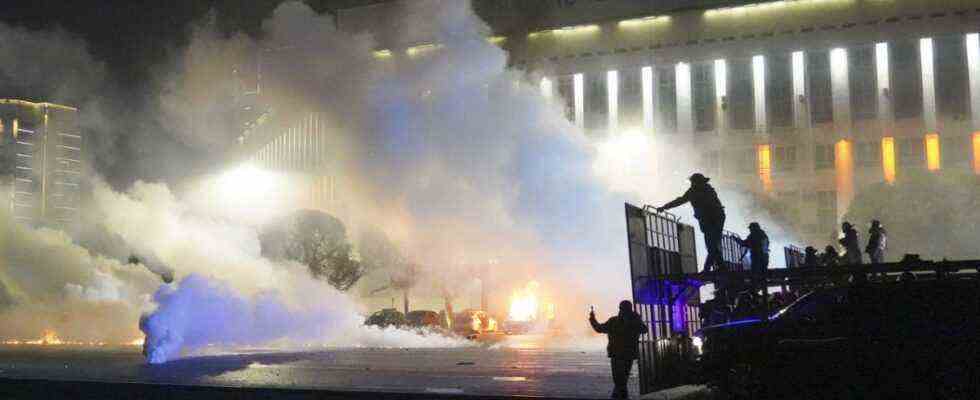The military intervened after violent riots in Kazakhstan in Central Asia. “Terrorist gangs” had fought a fight with paratroopers in the city of Almaty, said President Kassym-Jomart Tokayev in a televised address on Thursday night. He also asked a Russia-led security alliance in the region for help.
The Collective Security Treaty Organization (CSTO) should help counter a “terrorist threat,” said Tokayev. The “gangs” have taken control of large infrastructure facilities in the country. It is “not a threat, but an undermining of the integrity of the state”. Tokayev tried to calm the heated mood. “Do not respond to calls to storm official buildings. That is a crime,” said the head of state, who has been in office since 2019. The 68-year-old blamed “domestic and foreign provocateurs” for the current violence.
Almaty airport has also been “liberated” again, he reported. A “special operation” has started. On Wednesday afternoon, the airport announced that the airport had been evacuated and that the employees had left the site. The reason is that a crowd has occupied the building. Several airlines then canceled flights to Almaty.
It was the President’s second televised address in a matter of hours. In addition to Kazakhstan, the CSTO includes Russia, Belarus, Armenia, Kyrgyzstan and Tajikistan. Tokayev said in his address: “The situation threatens the security of all citizens of Almaty. It cannot be tolerated.” The security forces would act “as hard as possible”.
The president also announced reforms. But it was not concrete. He also imposed a state of emergency over several parts of the country, including Almaty and the capital Nur-Sultan. Russia called for a peaceful solution to the conflict. The US government and the EU made similar statements. Washington also called on the Kazakh authorities to exercise restraint.
Several dead, dozens injured
Previously, at least eight police officers and soldiers of the National Guard had been killed in violent riots in the Central Asian country. This was announced by the Interior Ministry according to the Kazakh media. 317 others were injured.
Especially in the western economic metropolis of Almaty, the former Alma Ata, in the southeast of the authoritarian republic, there had been serious clashes between demonstrators and security forces. Protesters had stormed the city administration and Tokayev’s residence in Almaty. Fires broke out there, as in several other public buildings. Videos and pictures showed police officers using stun grenades against the crowd. But burned-out cars could also be seen.
How many people took part in the protests was unclear. In the afternoon it was difficult to get an accurate picture of the situation. Networks were shut down – presumably to make new meetings more difficult. Several television stations stopped operating. Information reached the public with a corresponding delay. The authorities recently spoke of around 500 injured in Almaty alone, a western town that was called Alma Ata until 1993. There were protests in other cities as well. The head of state imposed a state of emergency over the entire republic.
Tokayev also ordered price cuts. Many demonstrators were not satisfied with that. The protests were triggered by higher liquid gas prices at filling stations. Many Kazakhs use liquefied petroleum gas because it is cheaper than gasoline. The government initially justified the higher prices with increased demand. Since the beginning of the year, gas trading has been carried out entirely on the energy exchange. Inflation rose sharply, which caused displeasure. The wave of protests quickly spread across the country. After Tokayev’s election in 2019 with an allegedly more than 70 percent approval, there had also been protests with hundreds of arrests.
Prime Minister Askar Mamin and his entire government resigned on Wednesday under public pressure. The previous vice Älichan Smajylow took over the official business. But even the resignation of the government did not calm the situation. It is the biggest wave of protests in the former Soviet republic in years.
How Astana became Nur-Sultan
For decades, Kazakhstan was ruled by Nursultan Nazarbayev. The now 81-year-old started out as a communist and was General Secretary of the Kazakh Soviet Republic. After the fall of the Communist Party in Moscow and elsewhere, he turned opportunely to nationalism. He cultivated nepotism, nepotism and became a very rich man himself. He sent members of the opposition to prison for years.
The capital Astana, which was rammed out of the steppe in 1998, was still called Astana until two years ago, but was then baptized Nur-Sultan, i.e. the first name of the head of state. Nursultan Nazarbayev ruled authoritarian to dictatorial until 2019 and then handed over the office of president to his self-appointed successor, Tokayev. But even after his official departure, the long-term ruler remained influential. Nazarbayev secured a position as “leader of the nation” in the constitution and remained head of the Security Council. Tokayev has now announced that he has taken over this post – and thus effectively ousted Nazarbayev.
The huge country with around 18 million inhabitants consists mostly of steppe. It has huge deposits of oil, gas and uranium. Nevertheless, Kazakhstan is struggling with mismanagement and poverty. Corruption is widespread. Kazakhstan borders among other things on Russia, China and the also authoritarian ruled ex-Soviet republics Tajikistan, Turkmenistan and Uzbekistan.

